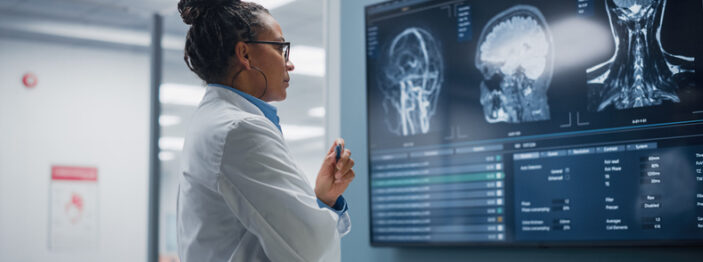Stem-cell transplantation: is it a cure for MS? Part 2
Part 2
Autologous hematopoietic stem-cell transplantation (aHSCT) is the most intensive, difficult and unpleasant treatment for multiple sclerosis (see Part 1), but is widely touted as the closest thing to a cure. That likely overstates the matter. But it can be a highly effective treatment – often the only treatment – for people with severe or rapidly worsening MS.
The first stem-cell transplant in MS was reported twenty-five years ago (Fassas and colleagues. Bone Marrow Transplant 1997;20:631-638) and about 5,000 people have undergone the procedure since then (Nabizadeh and colleagues. Neurol Ther 2022; epublished July 28, 2022).
Over the years there have been many reports that aHSCT can shut down inflammation in the central nervous system and stabilize the progression of disability for a period of time.
One long-term study looked at data for 281 people in two large international transplantation databases (Muraro and colleagues. JAMA Neurol 2017;74: 459-469). Most had secondary-progressive MS (SPMS, who are not the ideal candidates). Overall, 54% showed some type of disease progression in the five years after transplant. This was largely due to the SPMS group – 67% showed progression compared to 27% in the relapsing-remitting MS (RRMS) group. Disability progression was also slightly better than before in the RRMS group.
Since that time, the guidelines on who is a candidate for HSCT have become stricter. The preferred subjects are those with RRMS who have highly active disease, defined as two relapses or one relapse + new MRI lesions in the past year despite treatment with a disease-modifying therapy (DMT). Ideally, the person is younger than 45 years, has mild to moderate disability, and has been living with MS for fewer than 10 years (Sharrack and colleagues. Bone Marrow Transplantation 2020;55:283-306). People with aggressive MS, defined as developing severe disability in the past year, are also considered. People with progressive MS – arguably those who need help the most – are generally not candidates unless they have active inflammation (relapses and/or MRI lesions).
A more recent long-term study, which largely reflects the more stringent guidelines, was published earlier this year (Burt and colleagues. J Neurol 2022;269:2513-2526). Most of the 414 people in the study had RRMS although 22% had early SPMS. In the RRMS group, there was significant and ongoing improvement in the level of disability (from moderate to mild) over the five-year period. Disability significantly improved for people with SPMS – but only for a year; thereafter it was stable (which may be an achievement in itself). There was one death.
Interestingly, 20% of people with RRMS did experience a relapse in the five years post-transplant, indicating that HSCT did not shut down MS completely (so is not a cure). This also points to a limitation of HSCT: like DMTs, it successfully targets the inflammatory part of MS, but may have only an indirect impact at best on the neurodegenerative component of the disease.
How does HSCT compare with conventional DMTs?
This question was addressed in the phase II MIST study (Burt and colleagues. JAMA 2019;321:165-174). The study enrolled 110 people with RRMS who had at least two relapses in the previous year while taking a DMT (so considered highly active). The average age was 36 years when the study started.
The participants were divided into two groups: one received HSCT and the other got a different DMT than they one they had been taking. This comparison was not entirely fair. Of the 55 people in the DMT group, 16 received an injectable, 14 got Tecfidera, 1 got Aubagio and 2 got treatments that are not considered ‘disease-modifying’ – not the ideal therapies perhaps for people with highly active MS. No one received two of the most potent DMTs (Ocrevus and Lemtrada) since they were not yet approved for use in MS.
Overall, the proportion of people with worsening disability was 5% in the HSCT group compared to 62% in the DMT group over a three-year period; in the subgroup who received Tysabri (a better comparison), 31% had disability worsening. The level of disability improved somewhat in the HSCT group and worsened slightly in the DMT group. The proportion with no evidence of disease activity (no relapses, new MRI lesions or worsening disability) after four years was 79% with HSCT and 6% with Tysabri.
Infections – most often respiratory tract infections and urinary tract infections – were common following HSCT although the overall rate was low. The rate of potential long-term complications of HSCT, such as autoimmune disorders and cancers, is not yet known.
Thus, we see that HSCT is highly effective in shutting down the inflammation that causes the neuronal damage seen in MS, giving many people a reprieve from worsening disability. Despite these benefits, this form of treatment is too aggressive for many with MS, who have less severe disease and a slower rate of disability worsening. So the decision to undergo HSCT will depend on a careful examination of the risks and benefits. Unfortunately, for people with a progressive form of MS – either SPMS or PPMS – HSCT does not appear to be an especially effective option.
Share this article
Facebook Twitter pin it! Email
Related Posts
Back





